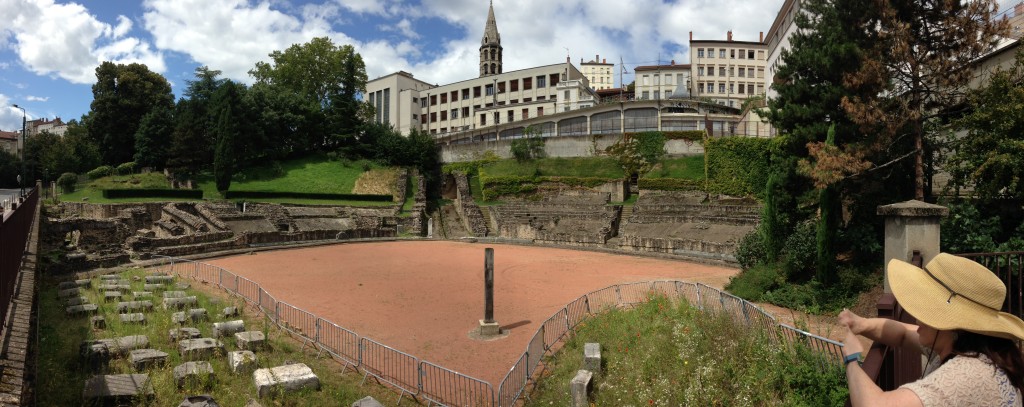
I grow tired of being herded like cattle on and off of tour buses and told I have 15 minutes of “free time” before I have to return to the bus.
And, I can only listen to so much about seventeenth century French architecture when I’m only a few blocks from the place where second century Christians refused to renounce their fidelity to King Jesus at the price of their lives.
So, two hours into this morning’s tour, we separated ourselves from the herd. Our first goal was to find a restaurant with wifi because, unbeknownst to you, I have grappled with the wifi on this ship for a week. It is sporadic at best, refuses to upload pics and calls up memories of Compuserve and cans with string.
The Wife, who, I may not have mentioned, is fluent in French, located a restaurant in Old Town Lyon that had adequate wifi (pronounced here, “wee fee”) but not a big enough canopy to cover the tables on the street. When it started raining, I was forced to eat and drank my Beaujolais with one hand, while holding an umbrella with the other. Fortunately, the food more than compensated for the inconvenience. Everything tastes better here.

After lunch, we set out for the ancient Roman amphitheater in Lyon. It was not part of the cruise ship’s tour, and it’s not easy to find. It’s tucked away in a part of Lyon not well trod by tourists, but it’s a place where the course of history was changed. It turned out to be the highlight of our day.
It was here (see picture above) in 177 AD, during the reign of Emperor Marcus Aurelius that the main scene of a vicious persecution against the church took place. It resulted in the martyrdom of many, including Pothinus, Alexander, Epipodius, Attalus, and Blandina.
Blandina was tortured and tied to a stake (commemorated in picture above) in the amphitheater for the wild beasts to devour her. To the amazement of all, she survived and still refused to renounce Jesus. Finally, she was put into a net and thrown to the bulls, where she finally met her death.
This and the accounts of the others who gave their lives for Jesus are not mere legend; they are recorded in a letter delivered by Irenaeus, a contemporary and presumably a witness, and that letter is quoted at length by Eusebius in his Ecclesiastical History. When Pothinus, who founded the church in Lyon, was martyred, Irenaeus replaced him as the leader of the church. Iraenaeus, you may recall from a previous post, had heard Polycarp preach. Polycarp was a disciple of John, the disciple of Jesus.
The sacrifice of the martyrs at Lyon and their proven love for Jesus must have had a profound influence on the cities of Lyon and Vienne. As we saw yesterday, within 200 years the city of Vienne converted their pagan temple into a church. Both were major Roman cities in Gaul (now France), complete with Roman-built forums, theaters and a hippodrome.
As Tertullian observed, the blood of the martyrs is the seed of the kingdom of God. Persecution purifies the Church. It separates those who truly love Jesus and have trusted in Him from posers and the merely religious. It is an x-ray for the soul. GS
